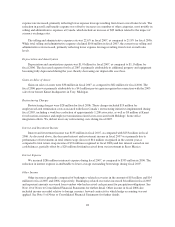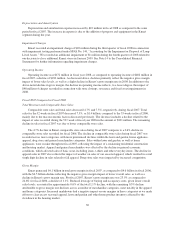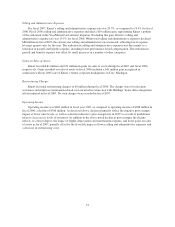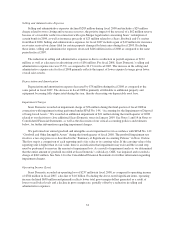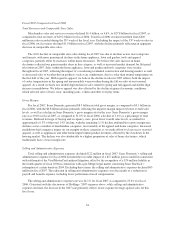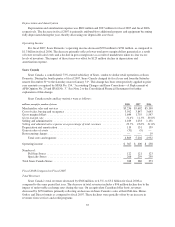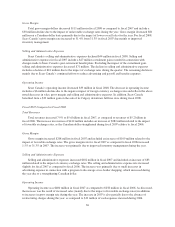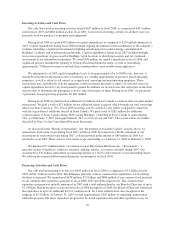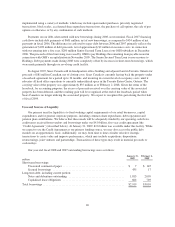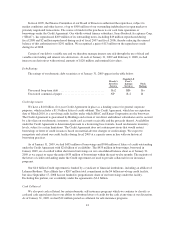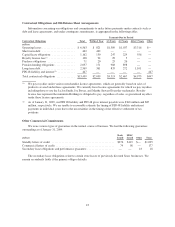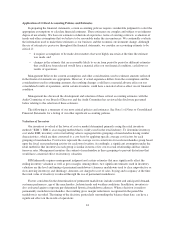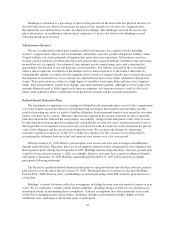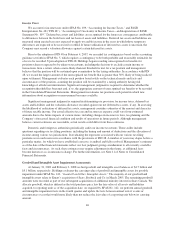Sears 2008 Annual Report Download - page 38
Download and view the complete annual report
Please find page 38 of the 2008 Sears annual report below. You can navigate through the pages in the report by either clicking on the pages listed below, or by using the keyword search tool below to find specific information within the annual report.within our Consolidated Balance Sheet at January 31, 2009. On February 20, 2009 we received a distribution of
$13 million of the total $38 million that had been held on deposit with The Reserve Primary Fund at January 31,
2009. We expect to receive our remaining investment during fiscal 2009.
We classify outstanding checks in excess of funds on deposit within other current liabilities and reduce cash
balances when these checks clear the bank on which they were drawn. Outstanding checks in excess of funds on
deposit were $228 million and $405 million for the fiscal year ended 2008 and 2007, respectively.
Investment of Available Capital
Since the Merger we have generated significant operating cash flows, and management expects that our cash
flows will continue to exceed our annual operating cash needs for the foreseeable future. We have and will
continue to invest in our businesses to improve the customer experience and provide the opportunity for
attractive returns. Further, as of January 31, 2009, we have repurchased approximately $5.0 billion of our
common shares since the Merger and may continue to repurchase shares subject to market conditions and board
authorization. In addition, we may pursue investments in the form of acquisitions, joint ventures and partnerships
where we believe appropriate returns can be obtained. Further, we may determine under certain market
conditions that available capital is best utilized to fund investments that we believe offer us attractive return
opportunities, whether or not related to our ongoing business activities.
As previously disclosed, our Board of Directors has delegated authority to direct investment of our surplus
cash to our Chairman, Edward S. Lampert, subject to various limitations that have been or may be from time to
time adopted by the Board of Directors and/or Finance Committee of the Board of Directors. During fiscal 2007
and 2006 we invested a portion of our surplus cash in various securities and financial instruments, including total
return swaps, which are derivative instruments that synthetically replicate the economic return characteristics of
one or more underlying marketable equity securities. We had no investments in total return swaps as of
January 31, 2009 or February 2, 2008.
Operating Activities and Cash Flows
As a retailer, Holdings’ primary source of operating cash flows is the sales of goods and services to
customers, while the primary use of cash in operations is to fund the purchase of merchandise inventories.
Holdings generated $992 million in operating cash flows during fiscal 2008, as compared to $1.5 billion in fiscal
2007. The decrease in net operating cash flows generated during fiscal 2008 as compared to fiscal 2007 primarily
reflects lower income, partially offset by an increase in cash generated from inventory reductions during the year.
Holdings generated approximately $1.5 billion in operating cash flows during fiscal 2007, as compared to
$1.4 billion in fiscal 2006. The increase in net operating cash flows generated during fiscal 2007 as compared to
fiscal 2006 primarily reflects a cash inflow of $66 million related to merchandise inventories in 2007 versus cash
used of $835 million in 2006, offset by an increase in cash used for income and other taxes, as well as decreased
net income.
Merchandise inventories at January 31, 2009 were $8.8 billion, as compared to $10.0 billion as of
February 2, 2008. Domestic inventory levels declined from $9.1 billion at February 2, 2008 to $8.1 billion at
January 31, 2009, despite the addition of $120 million of Kmart footwear inventory which was added when
Kmart began operating its footwear department in January 2009. Kmart’s footwear business had previously been
operated by a third party. Inventory levels at Sears Canada decreased $181 million, largely due to the impact of
foreign currency exchange rates. We continue to review and assess our merchandise inventory levels in an
ongoing effort to continuously improve overall returns. As we expect difficult economic conditions to persist in
the near term, we intend to continue to tightly manage our inventories throughout fiscal 2009. Merchandise
payables were $3.0 billion at January 31, 2009, as compared to $3.5 billion as of February 2, 2008. The decline
in merchandise payables is reflective of the overall decline in inventory levels during fiscal 2008.
38


